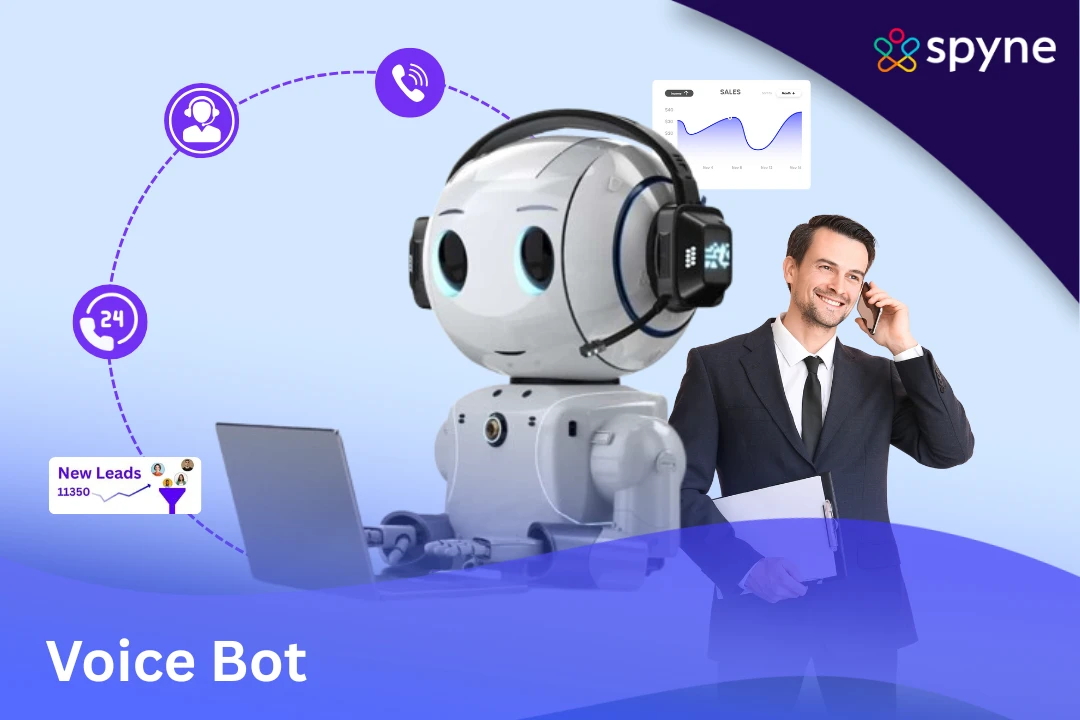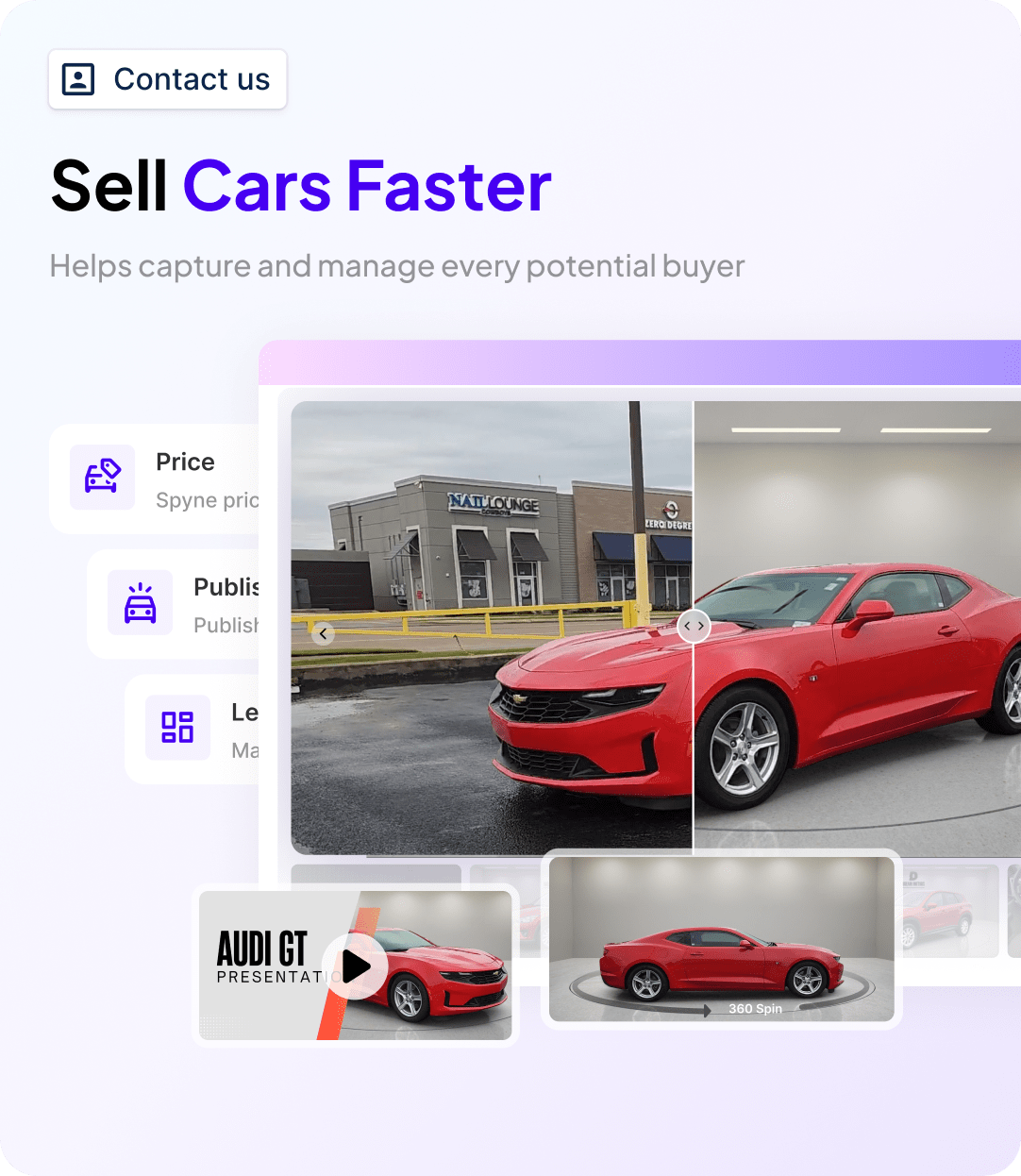In today’s fast-paced automotive market, customers expect immediate responses and seamless communication, no matter the time or channel. That’s where Spyne’s conversational AI voice bot comes in. Built specifically for car dealerships, this intelligent assistant helps you engage potential buyers and sellers instantly, whether they’re asking about vehicle availability, trade-in values, or booking appointments. Unlike generic solutions, Spyne’s voice bot is deeply integrated with automotive workflows and CRM tools, making it easy to manage leads, automate follow-ups, and improve sales team efficiency. With multilingual support and natural conversation flow, Spyne ensures every interaction feels human, helpful, and on-brand 24/7.
What is a Voice Bot?
A voice bot, which is short for voice-activated chatbot, is a smart tool that talks to people using their voice instead of typing. It works like a chatbot but listens to what you say and answers in a natural, human voice. Additionally, many businesses find that voicebots are very helpful in giving customers fast responses.
At its heart, a voice bot is a digital helper that understands your words and helps with tasks or gives information. You can find voice bots in smartphones, smart speakers, and customer service centers. They can answer simple questions or help with more difficult tasks.
A voice bot works in three main steps:
- Speech Recognition: Changes your spoken words into text.
- Understanding Using NLP (Natural Language Processing): Figures out what you want and the meaning behind your message to determine the output.
- Response Generation: Gives you the right answer or action using voice.
How Do Voice Bots Work?
A voice bot listens to what you say, understands your request, and talks back to you. It uses smart voicebot technology to make conversations smooth and easy. Businesses use voicebot platforms to help customers in places like voicebot call centers or on apps, saving time and effort.
1. Speech Recognition
The voicebot hears your voice first in order to get a better understanding of what you’re saying. Then, it changes the words you say into text. Additionally, it also removes the background noise so it only focuses on what you say and isn’t distracted by anything else.
2. Understanding Your Request
The conversational AI voice bot figures out the meaning behind your words. It determines what you want and need by looking at the whole sentence you say and the tone you say it in.
3. Finding the Right Answer
The voicebot conversational AI picks the best reply or action. It might check a database or perform a task for you.
4. Responding to You Clearly
Finally, the voicebot software changes its answer from text back into natural speech. This lets the voice chatbot respond to you clearly and quickly.
5. Learning and Personalization
Over time, AI voice bots learn from conversations to give better answers. Some voicebot platforms also remember past talks to make your experience more personal.
Voice Bot vs Chatbot vs IVR: Which One is the Best for Your Business?
There are important differences between voice bots, chatbots, and IVRs. Knowing these will help you pick the right one for your business. All three help businesses talk to customers automatically. IVRs use button presses, chatbots use typing, while voicebots listen and answer you with a natural voice for a better experience.
1. Voicebot: Natural Voice Conversations
A voice bot listens to your voice and talks back like a real person. Unlike IVRs, voicebot conversational AI understands the exact intent of what you’re saying, not just the words you’re saying. It does this by learning from conversations it had in the past, and so, it can handle tricky questions. You can find voicebot platforms in call centers and apps, making customer service faster and easier.
2. Chatbot: Help by Text
Chatbots communicate with customers using a text messaging service and not voice. So, you type the question you want to ask, and it answers using voicebot software that works in the background. These chatbots are good additions for your websites and apps, but maybe aren’t the most ideal if you want hands-free help or spoken answers. For that, a voice chatbot or conversational voice bot is better.
3. IVR: Simple Menus and Buttons
IVRs use recorded messages and ask you to press buttons to choose options. This type of auto attendant phone system is different from a voice bot, as it can’t understand normal speech and so can’t get smarter. This can frustrate customers, as they have to listen to long menus. Therefore, IVRs are good for simpler and basic tasks, but aren’t the best if you want smart features that AI voicebots have.
8 Best Use Cases of an AI Voice Bot for Your Business
AI voice bots help businesses automate customer interactions, improving service, sales, and support. They handle Voice Chat, sales calls, reservations, and even healthcare assistance with speed and ease.
1. Customer Service Made Easy
A voice bot AI can answer common customer questions, track orders, and guide troubleshooting. It saves time for agents by handling easy tasks, ensuring quick and helpful replies.
2. Banking and Finance Support
Banks use AI voice bots to check balances, report stolen cards, or spot fraud. The AI voice bot gives customers quick help without waiting for a human.
3. Better Shopping with Voice
In shopping, voice bot solutions help customers find products, place orders, and get delivery updates. Some stores even have a voice chat bot for easy assistance.
4. Healthcare Help Anytime
A conversational AI voice bot helps patients book appointments, get health advice, and send reminders. Hospitals use these for fast, 24/7 support.
5. Real Estate and Sales Boost
Real estate agents use bot voice tools to share property details, schedule visits, and manage leads. This way, the voice bot platform finds the right buyers faster.
6. Sales and Marketing Growth
Sales teams can use AI phone call voice bots to answer inquiries, follow up on leads, and suggest products. This boosts sales without extra work from the team.
7. Social Media and Fun Uses
Chatbots are popular on platforms like Discord, where people play games, watch movies, and listen to music. A voice chat bot helps answer questions and keeps conversations going. Even a temp voice bot can make social chatting fun and helpful.
8. Data and Insights
Businesses use voice bot online tools to record calls and gather customer insights. With text to speech and voice changer features, the AI bot voice generator helps in smarter and faster data collection.
Step-by-Step Guide: How Voice Bot Interaction Works
A voice bot interaction starts when you speak. Think of it like a conversation, because the bot listens, understands, and responds just like a human. It uses speech recognition, understanding, and text-to-speech for smooth and personal conversations.
Step 1: Speak to the Voicebot
The interaction starts when you talk to the voice bot. For example, you might say, “I need help with my order.” The voicebot technology listens, understands your request, and gets itself ready to help you.
Step 2: Converting Voice to Text
Next, the bot voice system hears what you said and then turns your speech into text using speech recognition. This is like a helpful nudge that enables the voicebot AI to understand exactly what you said.
Step 3: Understanding Your Request
Then, the voicebot conversational AI reads the text to properly understand what you asked. It even identifies the nature of the question, so whether you ask about weather or orders, the AI voice bot identifies your intent clearly.
Step 4: Finding the Right Answer
The conversational AI voice bot searches for any tools that might be connected to its answering service. These can be marketing apps or customer records. Tracing the intent of the question back to the source helps the bot find the correct information. This makes the voicebot contact center smarter.
Step 5: Talking Back to You
Once the voice bot platform finds the answer, it uses text to speech to reply in a human-like voice. The AI voice bot keeps the chat friendly and clear.
Step 6: Ready for More Questions
The voice chatbot stays ready for any follow-up, keeping the conversation smooth and helpful. Acting as a virtual sales assistant, it ensures that customer service is responsive, consistent, and always available.
An Introduction to Gen-AI Powered Voice Bots
A voice bot with Gen-AI has the ability to talk just like a human does. It can mimic a human’s natural-sounding tone and even talk with depth and emotion. It’s quite impressive, actually, as it listens to what you say and answers with the right emotion, tone, and even in different languages. This makes the bot’s voice feel more natural, and so, customers enjoy chatting with it more.
A conversational voice bot like this can understand more difficult and complex questions, remember your name, and give answers that feel personal. Whether it’s for sales or support, voice bot solutions can adapt to your needs. It also has features like voice chat, noise cancellation, and smooth voice chat bot experiences. Additionally, it works on apps, calls, and even platforms like voicebot for call center.
What is Generative AI?
Generative AI helps bots create new things like words, music, or images by learning from old data. In a voice bot platform, it means the AI voice bot can make fresh, clear answers every time. This AI voice chat bot doesn’t just follow scripts; it creates unique replies. That’s why tools like bot voice text to speech, AI voice bot, and ai bot voice generator are becoming so popular.
7 Key Components That Make a GenAI Voice Bot Work
An AI voice bot works with several smart features that help it talk like a human. These features make every voice chat bot experience smooth, helpful, and easy to follow.
1. Pre-training and Fine-tuning
The voice bot AI is trained on large amounts of data to understand words, patterns, and grammar. Then it’s tuned even more so that it can give proper answers to specific tasks and problems.
2. Automatic Speech Recognition (ASR)
This turns your spoken words into text that the conversational AI voice bot can understand. This feature helps it understand different accents, too, and even enables it to remove any background noise.
3. Natural Language Processing (NLP)
NLP helps the bot voice figure out what you mean by your words and the context.
4. Dialogue Management for Seamless Replies
This keeps the conversational voice bot responses clear and connected to the conversation.
5. Text-to-Speech (TTS) for the Human-like Element
TTS is the bot voice text to speech tool that reads responses aloud in a human-like voice.
6. Adaptive Learning for a Constant Learning Process
AI voice bot can learn from conversations and improve over time.
7. System Integration for Smooth Operations
The AI voice agent can connect with CRMs, making it great for a voice bot for call center or businesses.
Where Businesses Use a Generative AI Voice Bot in the Real World
GenAI-powered voice bots are helping many businesses by providing quick, friendly, and personalized support. These smart voice bot platforms work across industries, making customer interactions easier and more natural.
1. Making Customer Service More Satisfactory
Big companies like Amazon and Google use conversational AI voice bots to answer questions, track orders, and fix problems fast. These voicebot software systems work 24/7, freeing real agents for tougher tasks.
2. Healthcare that’s Fast and Accessible
In healthcare, AI voice bots help patients with reminders, answer health questions, and assist with basic check-ups. They make getting care easier anytime.
3. Banking and Finance, Simplified
Banks use voicebot call center tools to give real-time account updates, offer financial advice, and help with transactions securely and quickly.
4. E-commerce for Seamless Shopping
Online stores use conversational AI to recommend products, assist with orders, and offer help after purchase to improve the shopping experience.
5. Collections and Outreach
Voicebot contact center systems make collection calls and payment reminders automatic. They provide personalized messages that help companies save time and money.
6. Customer Support Innovations
Some businesses use voice chatbot tools to keep help articles updated, send timely messages to customers, support multiple languages, and coach agents during calls for better service.
9 Key Benefits of Using a Voice Bot for Your Business
A voice bot has many benefits for your business, like 24/7 support, faster customer service, cost savings, and easy scaling. Acting like a virtual receptionist, they help businesses handle more calls efficiently while keeping customers happy and satisfied.
1. Better Customer Experience
Since voice chat bots are trained using NLP, it’s easier to have conversations with them. It feels like you’re talking to a real person rather than a robot. They understand speech, solve problems fast, and reduce wait times. Therefore, this helps every interaction be similar to the last one, ensuring consistency and building trust.
2. Save Time and Reduce Costs
Conversational AI platforms look after the tasks that may take up time and burn out your team. They look after tasks like FAQs, booking, and payments, freeing human agents for complex issues. This cuts the cost of large call centers by managing many calls at once.
3. Scale Up Effortlessly
Conversational voice bots easily handle surges in customer calls or ongoing growth without extra staff. They work 24/7, helping global customers anytime, day or night.
4. Personal and Adaptive
AI voice chat bots remember past conversations and personalize replies. This is because of their ability to learn from and memorize all the interactions that happened earlier. Paired with AI lead scoring, they can also help businesses identify and prioritize the most promising prospects. This way, they improve over time to understand customers better.
5. Multilingual Support
Conversational AI online speaks many languages, so your business can connect with customers from different backgrounds. Additionally, it ensures customers stay connected in the language they’re comfortable with.
6. Manage High Call Volumes
A voice call bot may also offer overflow call answering features. This means it can handle thousands of calls coming in at the same time, and make sure no customer waits even during busy times.
7. Data-Driven Insights
Voicebot software collects real-time data from calls, helping businesses learn what customers want and how to improve services.
8. Stay Secure and Compliant
A conversational AI for a call center follows strict rules to protect sensitive customer information, reducing errors and boosting security.
9. Seamless System Integration
These solutions are quite flexible, meaning you can easily link a voice bot AI with CRM, databases, and apps for smooth, up-to-date customer information and faster service.
8 Key Features to Look for in a Voice Bot
A voice bot helps businesses talk to customers with real and personal conversations. Just because it’s AI doesn’t mean customers are stuck talking to repetitive software. With features like speech recognition and smart replies, it understands, responds, and makes interactions easier, faster, and more helpful.
1. Natural Conversations with Smart Understanding
A voicebot can understand what people say, even if they use short forms or slang. This makes chats easy, smooth, and almost like talking to a real person.
2. Personalized Replies with Memory & Context
The AI call bot remembers past conversations to give better answers each time. This saves time because customers don’t have to repeat the same information over and over again. This also helps them feel more understood.
3. Easy Integration with Apps & Systems
Conversational AI connects easily with your CRMs, apps, and databases. This keeps customer information updated and makes work faster and easier.
4. Multilingual & Culturally Aware Assistance
With a conversational AI online, businesses can talk to customers in many languages. It even understands local sayings and regional slang that a human agent may be unfamiliar with, making conversations friendlier.
5. Instant Voice Recognition & Natural Speech
Because of the bot voice text to speech feature, the conversational AI for call center can understand what people say using VoIP. This helps it respond back in a straightforward, clear, and human-sounding voice. Additionally, even if there’s background noise, the bot doesn’t get interrupted.
6. Sentiment Detection & Smart Upselling
A voice changer in the voice master bot can detect when a customer is upset or unsatisfied with their product or service. The bot recognizes their emotions and responds gently. It can also suggest other useful products without pushing the customer to make another purchase immediately.
7. Secure Data & Privacy Protections
The AI bot voice generator keeps customer data safe and follows privacy rules like GDPR and TCPA compliance. This is very important in industries like healthcare and finance.
8. Easy Handovers to Human Agents
The auto voice channel bot can easily pass the chat to a human when needed. This way, any issue the customer has can also be handled by a human, as live agents offer that sense of relatability and understanding that AI just can’t replace.
What are the Challenges of a Voice Bot and How Can You Overcome Them?
A voice bot is helpful, but it isn’t perfect. They can struggle with language, data safety, and personal touch. Here’s how to fix these common issues and make voice bots work better.
1. Understanding Complex Language
While they can understand slang and different accents, voice bots can still struggle with heavy usage of slang or thicker accents. Also, when a customer speaks too fast, it can confuse the bots. This leads to wrong replies and a poor experience.
Solution: Train the voicebot conversational AI on diverse voices and phrases. Regular updates help the conversational voice bot understand better.
2. Handling Long Conversations
At the end of the day, software is faulty. This means that voicebot technology can forget context in long talks, leading to confusion and frustration for customers.
Solution: Use memory features so the conversational AI voice bot remembers earlier parts of the chat.
3. System Integration Issues
If the conversational AI tool isn’t properly connected to your CRM or other systems, it may give customers old or incorrect data. This can affect people’s trust on your business.
Solution: Connect your AI voicebot with systems through APIs for smooth data sharing in the AI voice bot.
4. Privacy & Security Risks
Even if you take measures to keep your data secure, a breach in the program can really affect your privacy. The bot voice’s data can be hacked without proper security.
Solution: Apply encryption and audits so voicebot AI data stays safe and compliant.
5. Low User Trust
Users may avoid a stiff voicebot chatbot, thinking it doesn’t make sense to talk to a program that doesn’t have any emotions and can’t handle complex issues.
Solution: Make responses friendly and ensure a quick human handover if the voicebot software struggles.
6. Multilingual Gaps
A voice bot platform may not support all languages. This not only limits how much your business can reach other customers but can also make them feel uncomfortable, as some people aren’t used to chatting in English.
Solution: Pick a voicebot platform that includes global languages for better reach.
7. High Costs
Building chatbot voicebot systems can be expensive. They come with a lot of additional costs, such as call routing, integrations, and voice processing, and maintenance costs can be even higher.
Solution: Start small with a basic voicebot call center, then expand as ROI improves.
8. Missing Human Touch
Users dislike when the voicebot contact center feels robotic. Customers, especially, want a personalized experience.
Solution: Combine voicebot and chatbot services with human help for better care.
What Does the Future of Voice Bot Look Like?
Voice bots are evolving rapidly, becoming smarter, faster, and more human-like. From emotional awareness to task automation, the future of voice technology promises seamless, personalized, and intelligent customer experiences.
1. Smarter Understanding of Human Language
Modern AI voice bots are getting much better at understanding everyday speech, slang, and context. Thanks to advanced natural language processing, conversations with a conversational AI voice bot feel more helpful and human, with no more robotic replies.
2. Recognizing and Responding to Emotions
The future of bot voice tech includes emotional intelligence. Upcoming conversational AI solutions will detect how a person feels during a conversation and respond more empathetically, making every interaction more thoughtful and supportive.
3. Connecting with Smart Devices
Your AI voice bot won’t be limited to chat. Soon, it’ll connect directly with your car, home gadgets, or smart appliances, creating a seamless experience across devices using just your voice and a powerful voice bot platform.
4. Combining Voice with Visuals and Touch
Tomorrow’s voice chat bots won’t just speak, they’ll show you things too. Expect screens, visuals, and even touch controls to enhance how you interact with your AI bot voice assistant.
5. Personalized Experiences for Every User
A smart conversational AI will learn your habits, preferences, and history. That means more relevant suggestions, faster help, and conversations that feel tailored just for you, powered by AI and personalization.
6. Helping You Get Things Done Automatically
Voicebots are moving beyond Q&A. Future bots will actively complete tasks for you, like booking service appointments, sending follow-up texts, or managing calendars, essentially acting as an AI sales assistant, especially for industries like automotive or a voice bot for call center support.
7. Stronger Data Privacy and User Control
As voice bot platforms evolve, they’ll give users greater control over data and privacy settings. More transparency and better consent mechanisms will become the norm, making AI assistance safer and more trusted.
8. Faster, Seamless Conversations with Edge Computing
With edge computing, bot voice generators will process speech faster and work even when offline. That means near-instant responses and seamless voice chats no lag, no interruptions, even without a strong internet.
How Spyne’s Voice Bot is Changing the Way Car Dealers Talk to Customers
Spyne’s conversational AI voice bot transforms how dealerships connect with customers, offering 24/7 support, multilingual chat, CRM integration, and smart automation tailored specifically for the automotive industry.
1. Built for the Automotive Industry
Spyne’s AI voice bot is purpose-built for the automotive world. It helps car dealerships engage buyers and sellers instantly, whether it’s a lead asking about a car or a customer checking trade-in value. If you’re wondering, what is a voicebot? This is it: a smart, conversational assistant designed to streamline dealership communication.
2. Always Available, Across Every Channel
This voice bot platform works 24/7 through voice, chat, SMS, and even missed-call follow-ups. Spyne’s voice chat bot ensures no lead slips away, no matter the hour or communication channel, delivering the benefits of virtual receptionist services for car dealerships without the overhead, making it the perfect conversational AI for call center-like efficiency.
3. Speaks Your Customer’s Language
Our conversational AI is a top choice for dealerships thanks to its multilingual capabilities. Acting as a bilingual answering service, Spyne makes conversations feel natural and inclusive, whether your customers speak English, Spanish, or any other language, unlocking better engagement through localized voice chat.
4. Easy CRM and Workflow Integration
Spyne connects smoothly with your automotive CRM. From follow-ups to appointment bookings, this AI voice chat automates it all, saving hours of manual effort and helping you manage leads better with smart workflows and voice bot AI integrations.
5. Compliant by Design
Whether it’s contact timing or customer data, Spyne’s voicebot is compliant by design. It follows TCPA guidelines and state-level outreach rules, ensuring your business communicates professionally and stays protected, even with an AI bot voice managing interactions.
6. Understands Real Conversations
Spyne AI bot call for car dealerships understands customers, even when questions are casual, vague, or incomplete. It’s powered by smart AI bot voice generator technology that makes replies sound human and meaningful, not robotic.
7. Handles Tough Questions with Smart Routing
If the bot voice can’t fully assist, it instantly routes the customer to the right human agent, ensuring a seamless handoff and preserving high-value leads. That’s what makes it more than just another AI voice bot; it’s a true virtual assistant for dealerships.
8. Grows Smarter with Every Interaction
Spyne’s conversational AI solutions learn and improve with every conversation. Over time, your auto voice channel becomes better at converting leads, resolving queries, and boosting customer satisfaction, all with less human intervention.
Conclusion
Spyne’s voice bot isn’t just another chatbot; it’s a powerful, AI-driven solution designed to grow with your dealership. From answering tough customer questions to syncing with your CRM, it automates the entire communication journey while staying TCPA-compliant. It speaks your customer’s language, handles conversations naturally, and transfers complex queries to your sales team without missing a beat. Plus, it learns and improves over time. Whether you’re looking to reduce missed opportunities or boost lead conversion, Spyne’s AI voice is the tool you need. Book a free demo today and discover how Spyne transforms everyday conversations into closed deals.
















